

 The Accurate Reloading Forums
The Accurate Reloading Forums  THE ACCURATE RELOADING.COM FORUMS
THE ACCURATE RELOADING.COM FORUMS  Guns, Politics, Gunsmithing & Reloading
Guns, Politics, Gunsmithing & Reloading  Optics
Optics  Best low light optics??????????????
Best low light optics??????????????Go  | New  | Find  | Notify  | Tools  | Reply  |  |
| One of Us |
For the removal of doubt, Arild, that was a hypothetical situation, not an accusation. I guess you have one of those "specialised purposes" I mentioned. It may not be specialised in Europe but I understand most states in Australia and America prohibit hunting game at night. Many of my countrymen hunt pests at night with spotlights, legally, but once the light is on the quality of the scope becomes much less important. | |||
|
| new member |
sambarman338, You clearly have more hunting experience than I do and in the purchase and use of rifle scopes. What do you mean by "image-movement"? Also, what is "the decadence"? | |||
|
| One of Us |
Depends on the state and the games being pursued, whether or not it can be hunted at night. _____________________________________________________ A 9mm may expand to a larger diameter, but a 45 ain't going to shrink Men occasionally stumble over the truth, but most of them pick themselves up and hurry off as if nothing had happened. - Winston Churchill | |||
|
| new member |
Generally... GENERALLY ...game that has a season during which it can be hunted precludes it being hunted at night. | |||
|
| One of Us |
In most states, official hunting hours are one-half hour before sunrise to one-half hour after sunset. More than once I have spotted early evening game with binoculars only to find that I could not make them out in my scope. Almost as bad were the times I could see game with the scope but it was too dark to make out the reticle. I have since become a fan of high end optics and my favorite scopes are 6x42 fixed, though I do have others. I consider Leupold a decent baseline though they offer a few considerably better than baseline. What do pricey optics offer? The best optics have more uniformly made lenses. That costs more. Light is lost every time it passes from one medium to another. Inert gas filling helps reduce light lost when going from glass to gas between lenses. High tech lens coating systems also reduce light lost as it passes from gas to glass and back to gas again. The best coating systems cost more. Well made and properly sealed inert gas fills cost more. To illustrate differences in light transmission just look at these Leupold scopes: up to 82% light transmission in Vari-X I and Vari-X II up to 92% in Vari-X III up to 86% in VX-I an VX-II up to 98% in VX-III up to 92% in the VX-1 system up to 94% in the VX-2 system up to 98% in VX-3 Along with better ground glass, better gas fills, better seals, and higher quality lens coating systems, top notch optics also are mechanically superior to low priced optics. The design and operation of the erector system, adjusting system quality, and even the way the reticle is made differs from poor in cheap optics to excellent in high quality optics. Some people don't want or need to pay for high end optics. Some people want or have the need to pay for high end optics. Each to his own. But there IS a difference and no amount of pooh-poohing can make it go away. . | |||
|
| One of Us |
Light transmission is only part of the equation. To see well in low light the coats on the lens should enhance the blue light spectrum. _____________________________________________________ A 9mm may expand to a larger diameter, but a 45 ain't going to shrink Men occasionally stumble over the truth, but most of them pick themselves up and hurry off as if nothing had happened. - Winston Churchill | |||
|
| One of Us |
Not sure who you are directing this post, but many states allow pig hunting at night as well as coyotes. _____________________________________________________ A 9mm may expand to a larger diameter, but a 45 ain't going to shrink Men occasionally stumble over the truth, but most of them pick themselves up and hurry off as if nothing had happened. - Winston Churchill | |||
|
| new member |
If I'm mistaken correct me. Coyotes and hogs can be hunted all year, they don't have a dedicated season during which you can hunt them. If they had a season that means there would be months during the year where they cannot be shot. Coyotes and hogs aren't game animals, they're pests and nuisances, therefore you can hunt them year round at anytime during day or night. | |||
|
| One of Us |
Thus the need for excellent low light optics. _____________________________________________________ A 9mm may expand to a larger diameter, but a 45 ain't going to shrink Men occasionally stumble over the truth, but most of them pick themselves up and hurry off as if nothing had happened. - Winston Churchill | |||
|
| one of us |
wow! if you need that much light gathering Ya must be shooting game under a quarter moon, GET A SPOT LIGHT!! Ray Atkinson Atkinson Hunting Adventures 10 Ward Lane, Filer, Idaho, 83328 208-731-4120 rayatkinsonhunting@gmail.com | |||
|
| One of Us |
Since the game/pest questions have been sorted, I'll answer this one. Image-movement is what is also called "constantly centred reticle". Once, scopes either had the reticle fixed, like the old B&L 'Custom' scopes, where you changed the zero in the mounts, or it moved across your view and could finish up out of centre if the scope was not mounted properly. Image-movement (started by Kollmorgen/Redfield and Weaver about 60 years ago) made it appear the reticle was properly centred by pivoting the whole erector set in a smaller tube under the turrets, to move the target picture instead. This pleases the eye's inner nazi but requires a more-obvious field stop (to remind you the reticle is centred) which usually brings tunnel vision and possible reduction in FoV. It also makes the scope prone to zero loss because there is so much more rocking around inside under recoil and bumps. Other deficiencies have also been asserted. Therefore, image-movement is "the decadence". The Europeans resisted it for decades, either because they knew it was second-rate or because they were somehow locked out of the licensing. Since about 1985, though, most German and Austrian scopes have had image-movement, too - if you can't beat 'em, join 'em. | |||
|
| new member |
"Pest" question? I assure you I did not intend for that question to be anything more than gaining knowledge that I didn't have. Now I have it and it adds quite nicely to the store of basic facts regarding sporting optics that I've been trying to compile for some time now. Thank you. | |||
|
| One of Us |
Schmidt und Bender have upped their game! This is the scope that I have searched for. Now I have to wait for availability. | |||
|
one of us |
I think that 56mm objective is biggest reasonably possible on "standard hunting rifle". I use Zeiss Victory 3-12x56. When compared side by side to meopta R1, it was slightly better. But when compared years ago for example Zeiss 3-12x56 to "the same" Zeiss, but with fixed magnification 8x56, the fixed one won. I am not sure fixed ones are still in production. Jiri P.S. S&B still produce fixed rifle scopes. | |||
|
| one of us |
No shit!!!!!!!!!! and don't forget his 14.5 horses!!!!!!!!!!!!!!!!!!!! | |||
|
| one of us |
Bottom line, it is best to have 7mm to 5mm exit pupil. As an example, 8X56 fixed power scope = 7mm exit pupil. Or perhaps a 10X50 fixed power scope = 5mm exit pupil Or better yet a 3X12X56 variable power scope set at lowest setting = 7mm +++++++++++ The 5mm exit pupil or more, the better! From there you can determined which scope is the best under starlight and moon phases and the Europeans knows which is the best since most states in USA don't allow night time hunting. | |||
|
| One of Us |
In April, this jolly fatguy, is getting either a Zeiss HT 2.5-10x50 or a S&B 2.5-10x50 T96. Und mein vorld is brighter! | |||
|
| One of Us |
Just bought my first Meopta at THE DSC convention. 1.7 X 10 X 42 (R2). Put about 20 rounds through a 375 Weatherby I mounted it on. Really nice scope! Had to send my Kales 1.5 X 6 X 42 back to the shop. The variable ring became so stiff it would hardly move. Nice optic though. I will use it in the future as a backup to the Meopta. I compared the Meopta to the Leica REi at the Europtic booth. Both were very nice. I liked the reticle in the Meopta a little better and the lifetime transferable warranty. Probably would have bought a Leupold VX6 but was looking for a scope with hydrophobic lens coatings. The Leupold VX6 are very nice! I own 2 of those. EZ | |||
|
| one of us |
| |||
|
| One of Us |
What are you hunting? If you are a foot elk hunter or a steep / mountain hunter. I would leave most of the +15 oz scopes at home. Who makes the best low light scope in this category? Probably some form of fixed power 6X42. I believe someone made note of this before on this thread regarding higher investment in Euro binocs and a Leupold scope. I guess I fall into that category although I additionally Own Kahles, Meopta and Swar. scopes. Leupolds are on my rifles that are hung on my shoulder climbing steep hills. Leica HD plus's are around my neck. There is definite difference in the low light capability between these optics. I can make out more detail with the Leica but still can make the shot through the Leupold. | |||
|
| one of us |
As to low-light optics, I have tried my share. First off, those who take stock in what someone says in a magazine after "testing" scopes on a chart at 25 yards is fooling themselves if they think they are gaining anything truly useful in the way of beneficial real-world information. Granted, those tests may make for interesting reading and perhaps a basic guideline but does not take into account actual hunting conditions. A scope that tests well at 25 yards under controlled lighting may do poorly when atmospheric conditions come into play at longer ranges, and Mother Nature can quickly sort the wheat from the chafe when it comes to the quality of coatings and glass. That is why a Zeiss Terra 3-9x42 may be the "equal" of a Conquest 3-9x40 in a 25 yard resolution test, but if you check them out at 200 yards, you'll find the Terra -- while a good scope in its own right -- lagging distinctly behind its predecessor. I have spent many a night assessing scopes under moonlight and seeing how they actually do when dark-colored flesh and blood in the shadows is the object of attention. My health precludes me from getting out and hunting anymore, so having good glass for those few fleeting opportunities I may have for sniping game from the house becomes all-the-more important. And as to a scope being "bright" when one looks through it, I'll just say that is meaningless unless that optical characteristic is accompanied by ample resolving power, a reticle you can actually see and the ability to render a useful image under the worst of lighting conditions. I have by no means tested them all, and everyone's eyes are different. But here are more than two dozen scopes that have proven their mettle for low-light/moonlight hogs for ME. They are listed as they rate for my usage. Also, you'll notice that the top 4 all are FFP. And yes, the Victory 2.5-10x50 (have had 2 of them) outperformed both 3-12x56 models that I had). Lastly, I am putting this list together by memory. I do have detailed notes squirreled away in my loading room but really don't feel up to digging those out today. So I apologize if I have forgotten anything, but this is what comes to this feeble old mind for now: 1. Swarovski PV 2.5-10x56/#4 reticle (post-2000 model) 2. Zeiss Diavari Victory 2.5-10x50/#4 3. Meopta Meostar 3-12x56/#4 4. Zeiss Diavari Victory 3-12x56/#4 5. Kahles KX 3.5-10x50-plex (outstanding resolution/contrast allows the standard duplex to be seen) and Zeiss Conquest DL 3-12x50/#60 Ill. dot reticle 6. Meopta Meostar 4-12x40/#4, Zeiss Diavari Victory 2.5-10x42/#4 & Zeiss Conquest HD5 3-15x50/#20 7. Meopta Meopro 4-12x50 and MeoStar 3-10x50, both #4, and Kahles Helia C 8x56/4-a 8. Zeiss Conquest 3.5-10x50/#4, Kahles Helia CL SF 3-10x50/4-a and Zeiss Conquest 30mm 3-12x56/#4 9. Kahles Helia CL 3-9x42/SF/#4 10. Zeiss Diavari V 3-9x42/#20 and Zeiss Conquest MC 3-9x40/#4 11. Zeiss Conquest 4.5-14x50/#4 12. Swarovski PV 2.5-10x42/FFP/plex(post-2000 model) & Zeiss Conquest 4.5-14x44 (both plex & #4) 13. Swarovski Z3 4-12x50/4-a & Zeiss Diavari C 3-9x36/#20 14. Leupold VX-R 3-9x50/firedot duplex, Minox ZA5 HD 2-10x50 (Plex, BDC 600 & #4-a) and Meopta MeoPro 3-9x50/#4 15. Leupold VX-3 3.5-10x50/heavy duplex & Nikon Monarch 2.5-10x50 Nikoplex Any of these will serve the purpose well for moonlight hogs -- with some performing better or differently than others. You'll also notice that there are no low-powered versions listed. For my applications (since I can't close the distance), I need a scope that will work well at night using at least 7x and preferably 8 to 10x. There is no such thing as a perfect scope, but if I could take the image contrast of the Zeiss Conquest DL 3-12x50, the resolving power and light transmission of the post-2000 production Swarovski PV 2.5-10x56 and add a Zeiss #4 reticle with a micro-fiber illuminated dot (like the Conquest DL has), that might get me pretty close to "perfect." 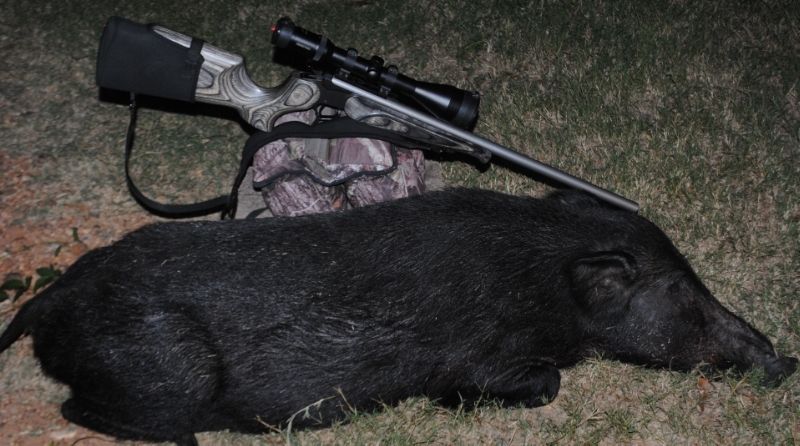 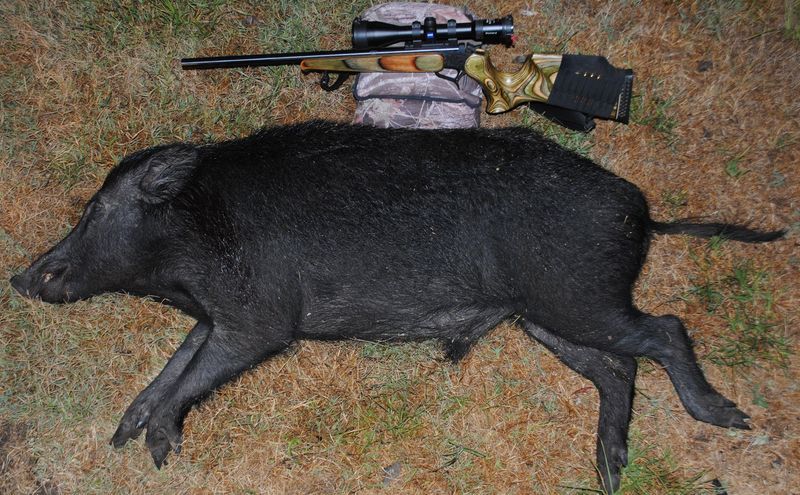 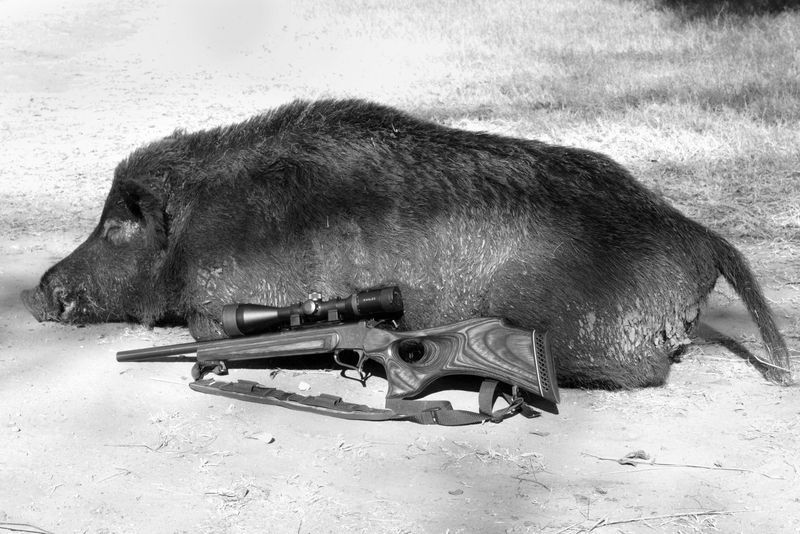 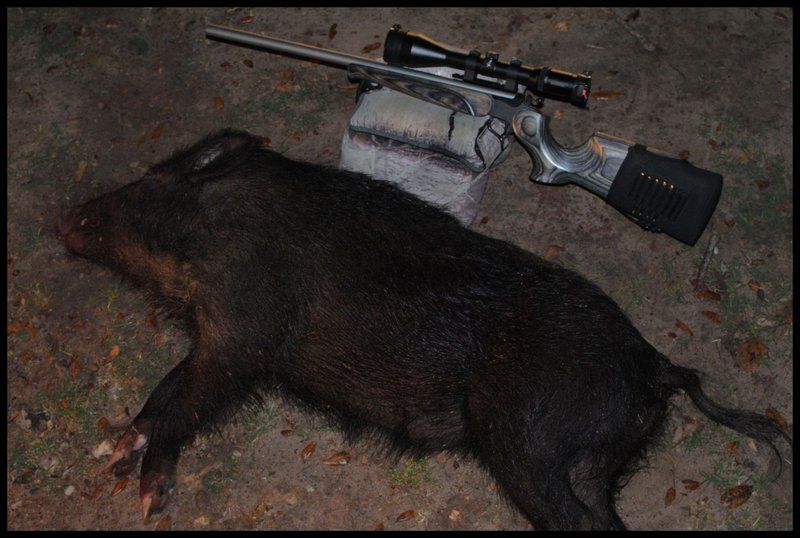 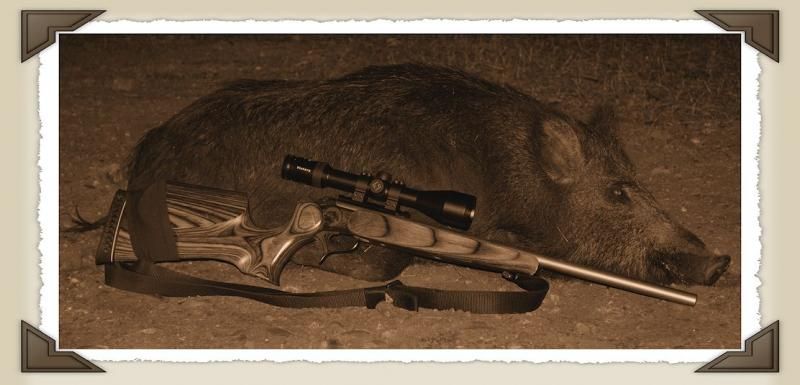  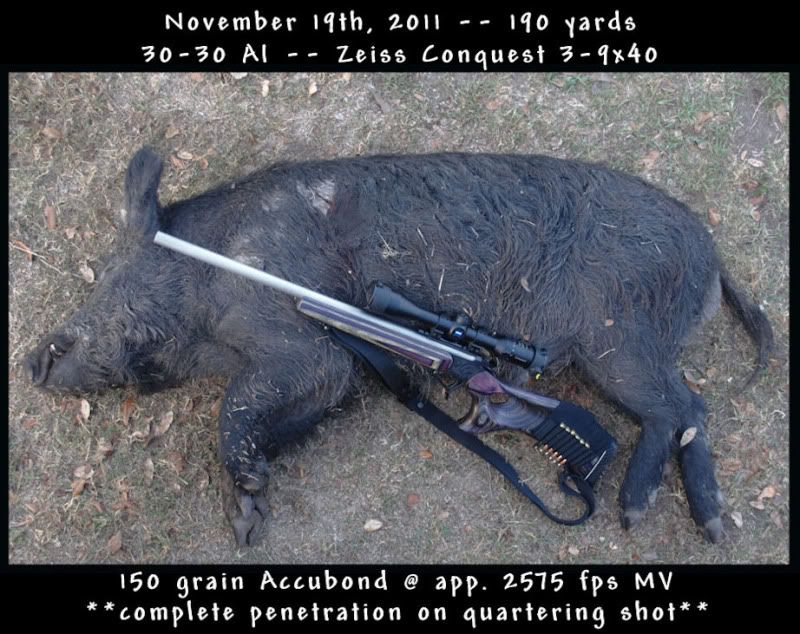 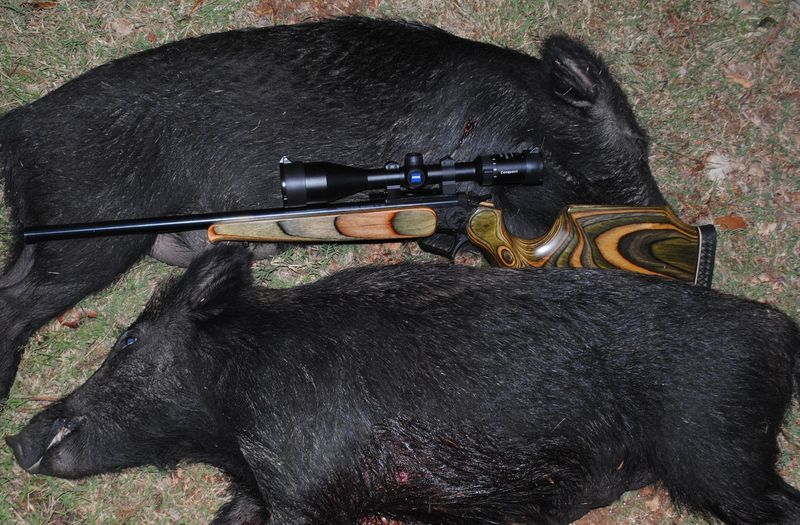 Bobby Μολὼν λαβέ The most important thing in life is not what we do but how and why we do it. - Nana Mouskouri | |||
|
| One of Us |
10-12 weeks to get my Polar T96, but she's ordered! I'm doing a happy dance! | |||
|
| One of Us |
Apparently they started "building" my T-96, still 3-4 weeks out. I need a 34mm set up. | |||
|
| One of Us |
This scope made by Kahles has been discontinued and was a 1-inch tube scope. It is the best 3-9x42 mm scope ever made by any manufacturer. Everything about this scope is as perfect as you can wish for. A riflescope is all about compromises, and this scope is in an apex position for general hunting in my humble opinion. Pieter | |||
|
| One of Us |
I have used them all. S&B is the best in low light for my eyes. It's always so quiet when the goldfish die.(Bror Blixen) DRSS Merkel 470 NE | |||
|
| One of Us |
Look forward to hearing how you like it. I'm very tempted by its bigger brother, the 4-16x56 T96 or the PM2 Ultrabright version... | |||
|
| One of Us |
Will do!! With many options and being new, it's a waiting game, to get what you want. | |||
|
| one of us |
I expected some challenges, and why wouldn't I, too many folks have high dollar scopes and nobody wants to admit a $300 scope is as good as a $1000 scope! That said, and yes I do have a high dollar clientele, but I also have some old boys that save, don't buy a new car every year, live in the same house and go hunt every year so whats that got to do with the thread!! I mostly attest to the Leopard blind or rather the big cat blind shooting, and early morning deer or bear blind hunts as my judgment opine, and Ive found that 2.5 and 3X fixed scopes are just as good as anything I've used. I also take into account that big scopes have a tendency to lose their POI as they get bounced around a lot on Safari, or in a saddle scabbard, and the more scope that sticks out the front ring the more problematic it is, if you doubt this then wack the crap out of your belled high dollar scope and shoot another 3 shots, then do the same with a 3X Leupold..I also find them a pain to pack around on the side of a mountain in Idaho. Right or wrong that's my opinion. To each his own, and just some advise from someone who has made a living hunting and offering advise to make hunts go smoothly, If you feel differently then Im good with that, as that's what conversation is all about..One can weigh each opinion, and make his own decision and with that he has to live.. Ray Atkinson Atkinson Hunting Adventures 10 Ward Lane, Filer, Idaho, 83328 208-731-4120 rayatkinsonhunting@gmail.com | |||
|
| One of Us |
$1000 ?! Try $2500 or even $4500 !! And even that is nothing compared to the cost of some of the rifles they sit atop; and yes we can debate all day about which is more important! The old adage here in low light N. Europe has always been to spend your money on the glass and the change on the rifle... I wonder why that should be? My own experience tells me that you simply cannot compare the image detail at 3x in low light versus 8x (or 10x, or ?x) with all else being equal, i.e. glass, exit pupil, etc. But to get that image, the front end must get bigger and the internals have to be built tougher, which adds cost. Not saying that all the cost is always justified, or that the extra performance is always needed. But if you need it, then you need it; and you have to pay for it. At the end of the day, as Warren Buffet is reputed to say, cost is what you pay, value is what you get. | |||
|
| One of Us |
If a $300 scope does everything you need to do then that's fine. But it doesn't mean you wouldn't have seen your target more clearly and more brightly with better optics. Quality of construction varies greatly between low grade and high grade optics. Proper collimation and a design robust enough to maintain it are very important. Most important for use in low light is that the lenses are precision ground and coated with multiple high tech materials that maximum light passage and minimize diffusion and refraction. Tight manufacturing tolerances, higher grade materials, precision grinding of lenses, multiple uniformly applied high-tech coatings, best possible alignment, and properly sealing of gases in and moisture out costs money. That's why Leupold's higher priced scopes are of better quality and have greater light transmission than their lower priced scopes and it explains why you find $300 Leupolds and $3000 Leupolds. It's also the basis for the differences between binoculars made by Leica or Swarovski and binoculars made by Bushnell or Nikon. Differences in light transmission and optical clarity between high and low end optics are very real. True, the shooter might not notice any difference on 100 yards shots in the middle of a bright day. But comparing high and low end scopes at 300, 400, or 500 yards or on rainy days or during the last 30 minutes of daylight reveals dramatic differences. Differences between low grade and high grade binoculars are even more apparent. . | |||
|
| One of Us |
I fully agree. And the older I get, the more important the optics are!! Most all my hunting is 100yds and less, and the most animal activity is when nearly dark. Ran a Very informal closer test last night (until about 1.25 hours after sunset), with 1-6x24's, 1.1-4x24's, 1.5-6x42's all European scopes. No question to my eyes the 42mm objectives are better, allowing more detail / definition / clarity / resolution whatever the correct term. Which is the same results that I have confirmed when hunting. Bottom line the 42mm's were usable longer than the 24mm's. This is not just referencing the reticles. Because in some I could still see the reticle but that was about it. And illuminated reticles do not help when the target can not be identified. "Low Light" description differs with people's opinion and the actual terrain. No doubt in my mind the larger objectives and quality glass with suitable reticle provide longer shooting time. I like straight tubed scopes, so the glass and reticle is Very important to me. But, in my comparison and prior experience they fall behind the 42mm and larger objectives. If, hunting within the shooting hours of 30min prior to sunrise and/or 30 min after limits, with equal glass and reticle there may not be much difference. Though terrain and environmental differences can effect this greatly. But, the larger objective will still offer more. ------------------------------------------------
| |||
|
| One of Us |
Tuesday or Wednesday!!! Apparently I'm the first, in Canada, to have a T96. I'm very excited!!!!!!!!! | |||
|
| One of Us |
I recall those sentiments about spending more on the scope than rifle back in the 1960s, and my understanding then was that it referred to the junk scopes of the time being mainly image-movement, while the good European ones stayed with the old reticle-movement system. I don't recall that it came from any obsession with the lens quality, simply that the cheap scopes were less likely to hold their zero. Whoever made it up obviously did not buy London rifles because the best Zeiss, Hensoldt and Nickel scopes H&H used cost half as much as the cases they sold with their guns. That improvement given by high powers in poor light is expressed as twilight value or factor - the square root of the magnification-multiplied-by-the-objective-lens-diameter. It may have no more validity than relative luminosity , which is putting a square peg in a round hole if ever I saw it (using the square of the exit pupil suggests we have square eyes and scope lenses). In the end I think Atkinson is right, though. When you can't see to shoot through a 3x scope, go home. Leave the forest to the night, your dinner is getting cold. | |||
|
| One of Us |
Of course every rule has exceptions and I don't suppose many of the people buying London rifles had to worry too much about change. But in our winter forests, you would be going home empty handed a lot of the time if you quit at 3x time... | |||
|
| One of Us |
| |||
|
| One of Us |
European night hunting and varmint hunting notwithstanding. That is the best reason Ive seen for taking low light scop[e capability's to the extreme limits. Here, the legal hours are 1/2 hour before and after. And as such, I have a $100.00 Bushnell Legend (I think it is rated @ 94% light transmission) that exceeds those needs and allows me to see pretty good even beyond the hours in which I am still willing to take a shot. For $1000-$3000 more, how much more light transmission is physically possible for ANY scope? Like Ray, the point of diminishing returns comes into play for me. There is a similar thread in another forum where someone dares bring the Bushnell name into the conversation, and not surprisingly the knee jerk reaction of some is to feel insulted. Personally, if Bushnell offered the durability and eye relief of of a Leupy, I would use them exclusively. I find some of their lenses to have incredible clarity and actually prefer them (in that aspect) to my Leupold and Redfields. AK-47 The only Communist Idea that Liberals don't like. | |||
|
| One of Us |
Without a doubt USN (ret) DRSS Verney-Carron 450NE Cogswell & Harrison 375 Fl NE Sabatti Big Five 375 FL Magnum NE DSC Life Member NRA Life Member | |||
|
| One of Us |
Well, plenty of doubt in my mind... I still look forward to seeing the S&B 4-16x56 (Polar T96 or PMII UltraBright) for myself, but they are rare as hens' teeth at the moment... | |||
|
| One of Us |
AWESOME READ BOBBY! LOTS OF GOOD INFO AND MANY YEARS OF EXPERIENCE .....YOU BE THE "NIGHT STALKER" ! Nice piggys too!.....Lots of Quality Choices now,just depends on your wallet! "That's not a knife..THIS is a KNIFE" ! | |||
|
| One of Us |
Yup depends on your wallet. I just bought another S&B, a 3-12x50. I paid the grand total of $1650 US dollars for it. The T96 was $1670 US dollars. Both illuminated and brand new from Germany. I paid 800 to 1000 US less than you folks south of the border | |||
|
| Powered by Social Strata | Page 1 2 3 4 |
| Please Wait. Your request is being processed... |
|
 The Accurate Reloading Forums
The Accurate Reloading Forums  THE ACCURATE RELOADING.COM FORUMS
THE ACCURATE RELOADING.COM FORUMS  Guns, Politics, Gunsmithing & Reloading
Guns, Politics, Gunsmithing & Reloading  Optics
Optics  Best low light optics??????????????
Best low light optics??????????????

Visit our on-line store for AR Memorabilia

